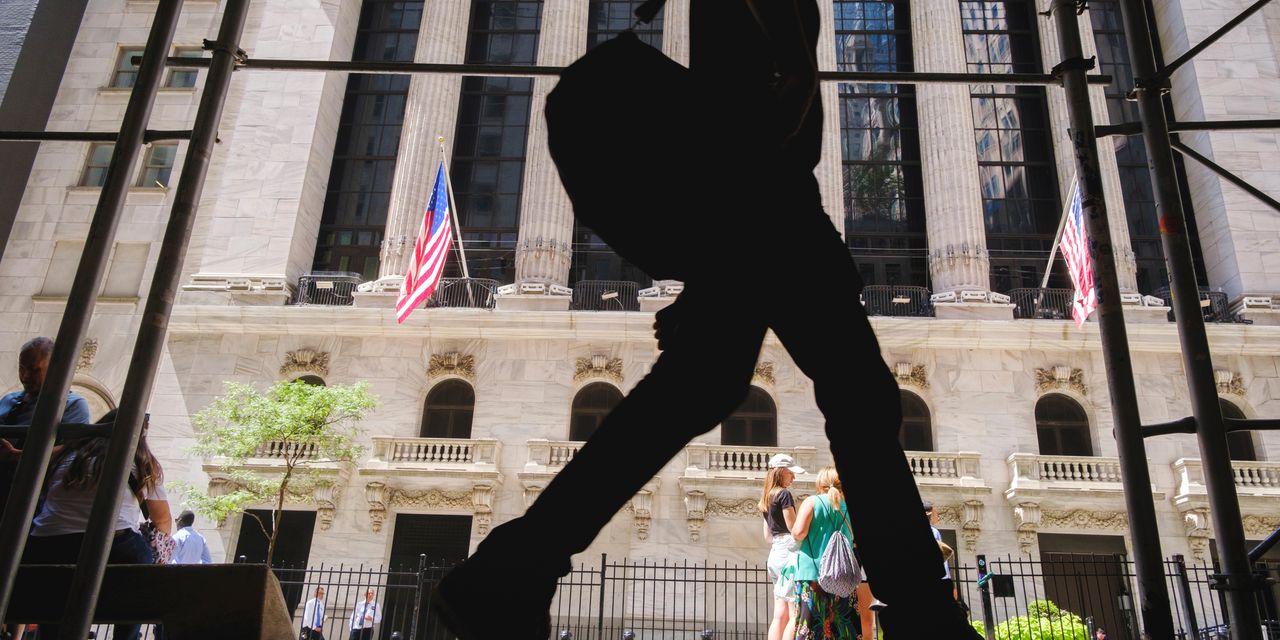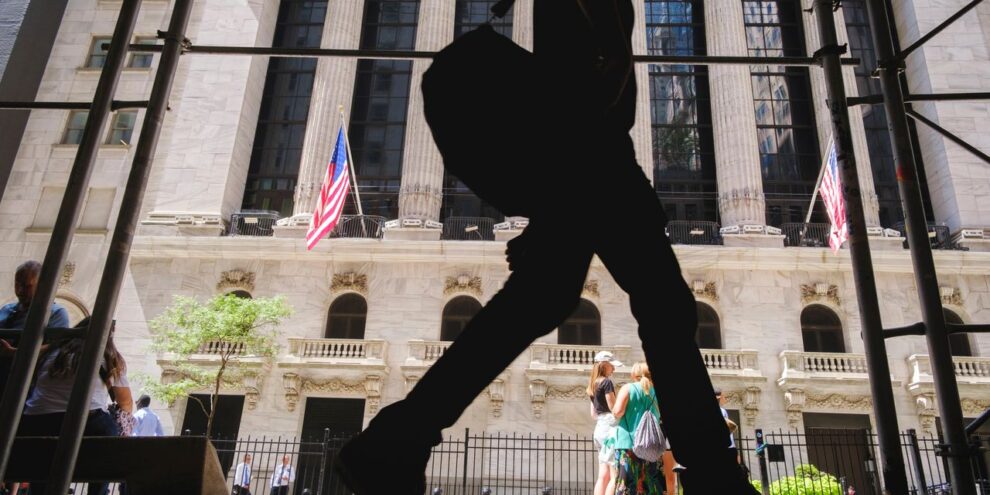
U.S. stocks traded lower on Friday afternoon, with the S&P 500 index and Nasdaq falling sharply, as investors digested more hawkish commentary out of the Federal Reserve and more than $2 trillion equity-linked options expired.
How are stocks trading?
- The Dow Jones Industrial Average DJIA, -0.67% was down about 248points, or 0.7%, at 33,751.
- The S&P 500 SPX, -1.14% dropped 53 points, or 1.2%, to nearly 4,231.
- The Nasdaq Composite COMP, -1.92% slid 268 points, or 2.1%, to 12,697.
On Thursday, the S&P 500 SPX, -1.14% rose 0.2% to 4,283.74, the Dow industrials DJIA, -0.67% rose less than 0.1% to close at 33,999.04 and the Nasdaq Composite COMP, -1.92% gained 0.2% to finish at 12,965.34.
What’s driving markets?
U.S. stocks are down Friday afternoon as investors assess a jump in Treasury yields and the prospect of the Federal Reserve potentially sticking with its aggressive monetary policy tightening as it battles high inflation.
After the U.S. stock market’s “tremendous” rally recently and with the “central bank tightening that’s in the pipeline,” it’s an opportune time to trim back on equities, according to Keith Lerner, co-chief investment officer of Truist Advisory Services.
“Valuations are pretty elevated after the rebound,” Lerner said in a phone interview Friday. A trading range for the S&P 500 of 4,200 to 4,300 is “less favorable” from a “risk-reward” perspective at this time, he said, while pointing to Friday’s jump in Treasury yields as hurting growth stocks in particular.
The S&P 500’s consumer-discretionary SP500.25, -2.14%, communication-services SP500.50, -1.87% and information-technology SP500.45, -1.71% sectors are among the hardest hit sectors in Friday afternoon trading, FactSet data show, at last check. Beyond growth stocks, the financials sector SP500.40, -1.99% was also declining, which Lerner attributed to concerns that Fed interest rate hikes to tame high inflation will lead to “a slower economy.”
The yield on the 10-year Treasury note TMUBMUSD10Y, 2.975% was up 10 basis points at 2.98% in early afternoon trading Friday, FactSet data show, at last check. “That’s a strong move,” Lerner said, adding that the 2-year Treasury yields TMUBMUSD02Y, 3.246% were also rising amid expectations for further rate hikes.
Meanwhile, inflation in Europe, including in Germany, is a reminder that “global central banks’ work is not done yet”, according to Lerner. He cited the sharp rise in Germany’s producer prices, reported Friday, as influencing U.S. investors’ concerns over high inflation and rising rates.
Read: German Producer Prices Post Highest Increase on Record
In the U.S., investors are assessing the odds of the Fed potentially raising its benchmark rate by 75 basis points at its September meeting.
St. Louis Fed President James Bullard told The Wall Street Journal on Thursday that he would “lean toward” a 75 basis point hike in September. Speaking Friday morning, Richmond Fed President Tom Barkin said the Fed “will do what it takes” to drive inflation back toward its 2% target, Bloomberg reported, while Reuters reported Barkin saying the Fed’s efforts needn’t be “calamitous.”
Interest-rate sensitive tech stocks have been bruised this week, with the Nasdaq on track for a 2.7% weekly drop, according to FactSet data, at last check. The S&P 500 was down 1.2% so far this week, while the blue-chip gauge Dow Jones Industrial Average was about flat.
That would mark a pause from the stock market’s recent rally. Last week the S&P 500 and tech-heavy Nasdaq each booked their longest weekly win streak since November 2021, after rising for a fourth straight week.
See: Stock-market rally faces key challenge at S&P 500’s 200-day moving average
Friday is devoid of major U.S. economic data, leaving investors to digest comments from Fed officials while dealing with the monthly expiration of more than $2 trillion worth of stock and index options. The expiration of options can exaggerate market moves, said Lerner.
Next week, investors will be shifting their focus toward what Fed Chairman Jerome Powell will say during the Fed’s annual economic symposium in Jackson Hole, Wyo.
“I think everybody is just waiting for Jackson Hole, so I think there will be a lot of speculation over what Powell is going to say for the next five days,” said Brad Conger, deputy chief investment officer at Pennsylvania-based Hirtle Callaghan & Co., which oversees about $20 billion in assets, mostly on behalf of university endowments.
See: Powell to tell Jackson Hole that recession won’t stop Fed’s fight against high inflation
Which companies are in focus?
- Bed, Bath & Beyond Inc. BBBY, -40.22% shares tumbled almost 40% after investor Ryan Cohen has confirmed that he sold his entire stake in the retailer, and earned a profit of more than $58 million.
- Shares of Deere & Co. DE, +0.14% slipped 0.2% after the tractor maker reported fiscal third-quarter profit that missed expectations, owing to higher costs and production inefficiencies, but its revenue beat forecasts.
- Shares of Foot Locker Inc. FL, +19.74% rose almost 20%, boosted by the sneaker retailer’s second-quarter results.
- Shares of Weber Inc. WEBR, -1.30% fell 2.7% after surging above $10 a share a day earlier for the first time since June.
How are other assets trading?
- The U.S. dollar index DXY, +0.54%, a gauge of the dollar’s strength against a basket of rivals, rose 0.5%.
- In oil futures, West Texas Intermediate crude CL.1, -0.02% for September delivery dropped was up 1% at $91.39 a barrel.
- Gold prices fell, with December futures for the precious metal GCZ22, -0.45% declining 0.5% to $1,763 an ounce.
- Bitcoin BTCUSD, -8.54% fell 8.2% to $21,502.
- In European equities, the STOXX Europe 600 Index closed 0.8% lower Friday for a weekly decline of 0.8%. London’s FTSE 100 index gained 0.1% Friday and rose 0.7% for the week.
- In Asia, Japan’s Nikkei 225 NIY00, -1.29% closed less than 0.1% lower Friday, while Hong Kong’s Hang Seng index HSI, +0.05% gained less than 0.1. % and China’s Shanghai Composite Index fell 0.6%.
—Barbara Kollmeyer contributed to this report.









